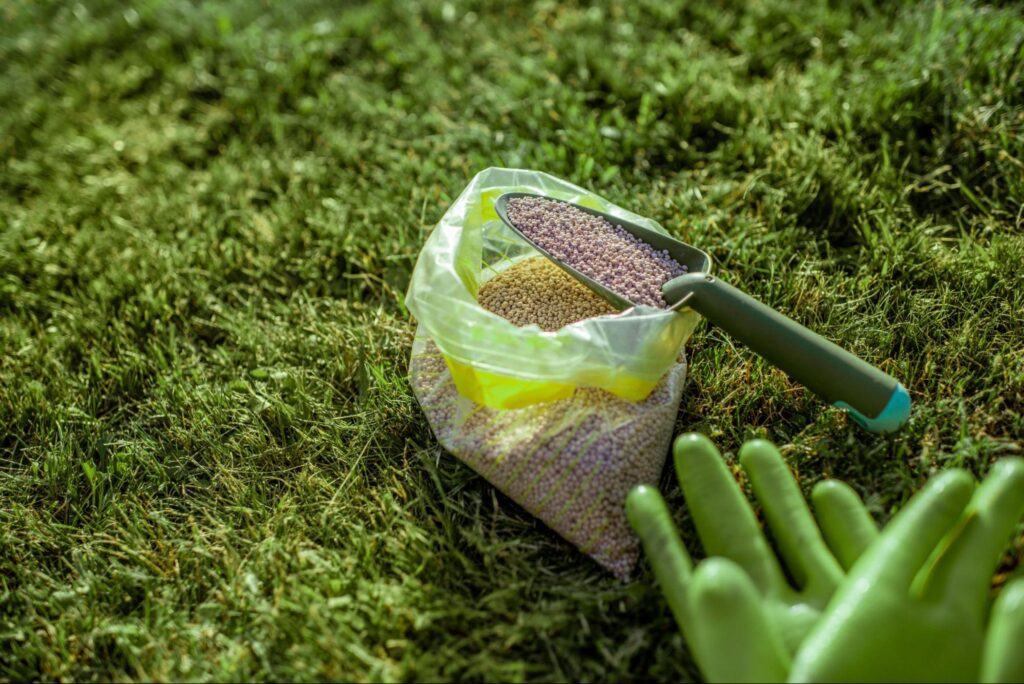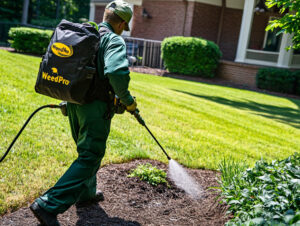When it comes to maintaining a lush and vibrant lawn, the choice between liquid and granular fertilizer can seem daunting. Achieving that deep green color is a common goal for many homeowners, and your fertilizer choice plays a major role in making it happen. At WeedPro, we’ve made it our mission to help Georgia homeowners understand the pros and cons of each fertilizer type so they can choose the best option for their lawn’s unique needs. In this guide, we’ll dive into the essential characteristics of both liquid and granular fertilizers, helping you make a well-informed decision that supports a healthy, thriving yard. Some fertilizer options can even help save time by combining multiple lawn care steps or streamlining the application process.
Determining Your Lawn’s Needs: Soil Testing and pH
Why Test Your Soil?
Before you choose between liquid fertilizers, granular fertilizers, or any other type of lawn fertilizer, it’s essential to understand what your soil actually needs. A soil test is the first step in creating a fertilizing plan that supports healthy plant growth and robust root development. By analyzing your soil’s nutrient content and nutrient availability, a soil test reveals any deficiencies or excesses—such as a lack of phosphorus, which is crucial for root development, or an overabundance of certain nutrients that could harm your lawn. This targeted approach helps you select the right fertilizer, whether it’s phosphorus fertilizers for root growth or a balanced blend for overall health. Testing your soil not only improves soil quality and plant health but also prevents the risks of over-fertilizing, which can lead to nutrient runoff and environmental issues. Ultimately, soil testing ensures your lawn receives the essential nutrients it needs for lush, green growth, making your fertilizing efforts more effective and sustainable.
How to Conduct a Soil Test
Conducting a soil test is straightforward and can make a significant difference in your lawn’s health. Start by collecting a soil sample: use a clean trowel to take small amounts of soil from several spots across your lawn, digging down a few inches to reach the root zone. Mix these samples together in a clean container to get a representative sample of your lawn’s soil. You can then use a DIY soil test kit, following the instructions to check for essential nutrients like nitrogen, phosphorus, and potassium, as well as the soil’s pH level. For more detailed results, consider sending your soil sample to a professional laboratory, which will provide a comprehensive analysis of your soil’s nutrient levels, including phosphorus and potassium. Understanding these results allows you to choose fertilizers that supply the right balance of nutrients, ensuring your lawn gets the nitrogen, phosphorus, and potassium it needs for healthy growth.
Understanding Soil pH and Its Impact on Fertilizer Choice
Soil pH is a key factor in determining how well your grass plants can absorb nutrients from fertilizers. Most lawns thrive when the soil pH is slightly acidic to neutral, typically between 6.0 and 7.0. If your soil pH falls outside this range, certain nutrients—like iron, manganese, or phosphorus—may become less available to your grass, even if you apply fertilizer. For example, a high soil pH can lock up micronutrients, while a low pH can make phosphorus more available but may also increase the risk of nutrient imbalances. By knowing your soil’s pH, you can select the right type of fertilizer—whether it’s organic fertilizers, synthetic fertilizers, or liquid fertilizers—formulated to work best within your soil’s specific conditions. If adjustments are needed, soil amendments such as elemental sulfur or lime can help bring your soil pH into the optimal range. This ensures that the essential nutrients in your chosen fertilizer are accessible to your grass plants, supporting vigorous growth and a healthy, green lawn.
Understanding Liquid Fertilizer
Defining Liquid Fertilizer
Liquid fertilizers are nutrient solutions mixed with water, designed to penetrate the grass quickly and be easily absorbed by the plants. Liquid fertilizers can also be applied directly to plant leaves for rapid absorption through foliar feeding. Foliar applications are a common method for providing nutrients quickly to grass and plants, allowing for faster visible improvements in growth and color. This type of fertilizer is often used for a rapid nutrient boost and can deliver essential vitamins and minerals directly to the roots, enhancing growth and color.
Benefits Of Liquid Fertilizer
Quick Nutrient Absorption: One of the primary advantages of liquid fertilizers is their fast-acting nature, allowing for quick assimilation by the grass. This can be particularly beneficial if your lawn is showing signs of nutrient deficiency, as it leads to a rapid green up of the lawn.
Efficient Coverage: For large lawns, liquid fertilizers can often cover more area without the risks associated with missed spots that can occur with granular products.
Ideal for Quick Fixes: If your lawn is in distress, liquid fertilizers can provide much-needed relief, helping your yard bounce back more rapidly than granular options might allow. They are especially effective at stimulating new growth after periods of stress. Many liquid fertilizers contain fast release nitrogen, which contributes to their quick results.
Drawbacks Of Liquid Fertilizer
Increased Frequency of Application: Liquid fertilizers generally require more frequent applications, which can be a drawback for busy homeowners looking for low-maintenance solutions.
Potential for Runoff: If applied excessively, liquid fertilizers can lead to nutrient runoff, which not only diminishes effectiveness but can also negatively impact local water sources.
Specialized Equipment Needed: To apply liquid fertilizers effectively, you may need additional tools, such as a sprayer, which can involve extra investment and setup time.
Understanding Granular Fertilizer
Defining Granular Fertilizer
Granular fertilizers consist of dry granules that are spread evenly across the lawn. These products are often formulated as slow release fertilizers or controlled release fertilizers, designed to provide nutrients gradually over an extended period. When watered, these release fertilizers dissolve and gradually supply fertilizer nutrients to the lawn over time, making them an excellent choice for sustained feeding.
Benefits Of Granular Fertilizer
Steady Nutrient Release: Granular fertilizers are designed to release nutrients over time. This slow-release mechanism promotes prolonged growth and reduces the need for frequent applications, making them more convenient for homeowners who prefer hands-off lawn care. Granular fertilizers are especially suitable for established lawns that require ongoing maintenance.
Lower Risk of Nutrient Burn: Many granular options, especially slow-release types, significantly reduce the likelihood of fertilizer burn, which can occur if lawns receive too much concentrated nutrients at once.
Ease of DIY Application: Granular fertilizers can be easily applied using a simple spreader, eliminating the need for specialized equipment, and making them accessible for DIY enthusiasts. They are often an affordable option for homeowners due to their cost-effectiveness and ease of use.
Drawbacks Of Granular Fertilizer
Slower Results: Unlike liquid fertilizers, the effects of granular products are more gradual, which may not meet the urgent needs of a struggling lawn.
Application Challenges: Proper technique is required to distribute granular fertilizers evenly. If not applied correctly, you risk patchy growth or skipped areas.
Requires Proper Watering: After application, granular fertilizers must be watered in to activate, meaning you have to coordinate with your irrigation schedule.
Comparative Analysis: Liquid Versus Granular Fertilizer
Quick-Release Vs Controlled-Release
Liquid fertilizers often provide a quick-release effect, making nutrients available almost immediately. Fast release nitrogen is often used in these products for rapid results, especially when quick greening or recovery is needed. In contrast, granular fertilizers can offer either quick-release or controlled-release options, allowing you to choose based on your lawn’s needs and your preferred level of maintenance. Since turfgrass typically requires more nitrogen than other nutrients, this is an important factor to consider when selecting between quick-release and controlled-release products.
Nutrient Availability
Both liquid and granular fertilizers are designed to provide essential fertilizer nutrients to the lawn. With liquid fertilizers, nutrient availability is immediate, allowing for rapid treatment of deficiencies. Granular fertilizers, but, provide nutrient availability over a more extended period, supporting long-term growth and health. The main goal of either method is providing nutrients in a way that matches the lawn’s needs.
Application Methods
Liquid fertilizers are typically applied using sprayers, making them suitable for large areas with a focused application. Granular fertilizers, on the other hand, are applied directly to the ground and require watering in to activate the nutrients. Some granular and liquid fertilizers are combined with weed control products, allowing you to target weeds while fertilizing the lawn. The timing and method of application can significantly impact how effectively weeds are controlled during fertilization, as proper ground-level application ensures both nutrient absorption and weed prevention. Granular fertilizers require spreaders, which can be easier for an even, controlled distribution but necessitate more manual effort.
How To Apply Liquid Fertilizer
Required Tools For Application
To apply liquid fertilizer effectively, you’ll need a garden sprayer or a hose-end sprayer. Make sure to have all necessary safety gear, such as gloves and goggles, especially if using concentrated formulas.
Step-By-Step Application Process
Dilute: Follow the label instructions for dilution ratios.
Fill: Pour the solution into the sprayer, ensuring it’s securely closed.
Spray: Evenly apply across the lawn, focusing on areas that require the most attention. For foliar applications, spray the fertilizer directly onto plant leaves to enable rapid nutrient absorption through the leaf surface.
Water: If necessary, water lightly afterward to help the nutrients penetrate the soil.
How To Apply Granular Fertilizer
Required Tools For Application
For granular fertilizer, you’ll need either a drop-type or rotary spreader for even distribution. Ensure your spreader is calibrated for the correct application rate based on the product instructions.
Step-By-Step Application Process
Calibrate: Adjust the spreader settings according to the package instructions to ensure you’re applying the right amount.
Apply: Walk in straight lines, making sure to overlap slightly to avoid skips.
Water: After applying, water your lawn to activate the granular fertilizer, facilitating nutrient absorption.
For best results, leave grass clippings on the lawn after mowing. Grass clippings help recycle nutrients like nitrogen back into the soil, reducing the need for additional fertilizer and extending its effectiveness.
When applying granular fertilizer to a new lawn or new lawns, use a starter fertilizer and follow specific seeding or sodding guidelines. For new lawns, the entire recommended liming amount should be tilled into the soil before planting to ensure proper pH balance and healthy establishment.
Factors To Consider When Choosing Fertilizer
Soil Type And Condition
Before selecting between liquid and granular fertilizers, conducting a soil test is crucial. Reviewing soil test results will help you understand nutrient deficiencies, soil composition, and determine which amendments or fertilizers are needed to improve soil health. Healthy soil’s microbial life and organic matter content are important for nutrient cycling and plant health, so consider these factors when choosing your fertilizer strategy.
Timing And Frequency Of Application
Consider your lawn’s growth cycle. Early fall is an optimal time to fertilize cool-season grasses, as this helps prepare them for cold weather and promotes recovery after summer stress. Lawns should be fertilized with products containing potassium and phosphorus to help them withstand cold weather and recover in spring. If you need quick results, liquid fertilizers might be best during peak growth, while granular can maintain health through the slow-release method during off-peak periods.
Lawn Type And Climate Considerations
Some grass types thrive better with certain fertilizer types. Cool-season grasses may prefer granular fertilizers during their growing season, while warm-season ones might benefit from quick liquid application during hot months. Turf and turfgrass have specific nutrient requirements that can vary by season and climate, so it’s important to tailor your fertilization approach accordingly. Established lawns often require different fertilizer strategies than new lawns, with a focus on maintaining turf quality and meeting ongoing nutrient needs.
Choosing between liquid and granular fertilizer eventually boils down to your lawn’s specific needs, your application preferences, and how much time you want to commit to lawn care. Liquid fertilizers offer rapid results and are ideal for quick fixes, while granular fertilizers provide sustained nutrient delivery and convenience. By understanding the distinctions between these two types of fertilizers, you can make informed decisions that will help keep your lawn healthy, thriving, and picture-perfect throughout the year.
Frequently Asked Questions about Liquid vs Granular Fertilizer
What is the difference between liquid and granular fertilizer for lawns?
Liquid fertilizers provide quick nutrient absorption and are best for immediate needs, while granular fertilizers offer a slow-release mechanism, ensuring long-term nutrient supply and fewer applications.
How often should I apply liquid fertilizer to my lawn?
Liquid fertilizers usually require more frequent applications, often every 2-4 weeks, depending on your lawn’s specific needs and growth conditions.
Can granular fertilizer burn my lawn?
Yes, while granular fertilizers typically have a lower risk of nutrient burn compared to liquid options, it’s essential to follow recommended application rates to avoid damage.
What conditions are ideal for using liquid fertilizer?
Liquid fertilizer is best used when rapid nutrient delivery is needed, particularly during periods of stress or deficiency in the lawn’s growth cycle.
How does soil type affect fertilizer choice?
Soil type can significantly influence fertilizer choice; for instance, liquid fertilizers may be better for sandy soils for quick nutrient absorption, while granular fertilizers suit clay soils for sustained release.
Which fertilizer is more environmentally friendly?
Granular fertilizers often have a lower risk of nutrient runoff compared to liquid fertilizers, making them generally more environmentally friendly when applied correctly.







